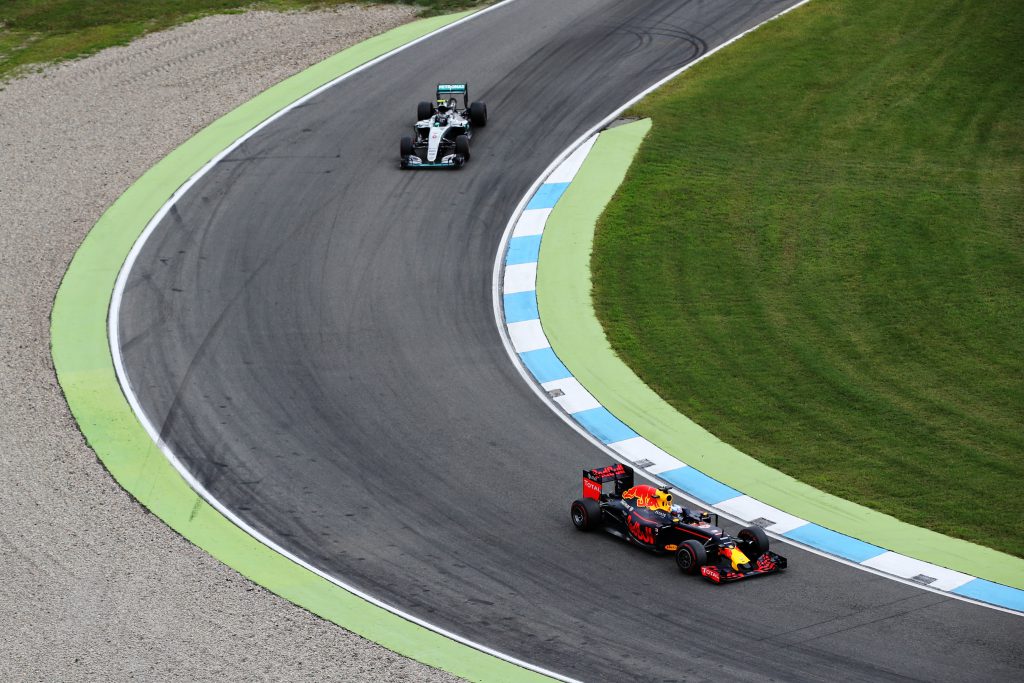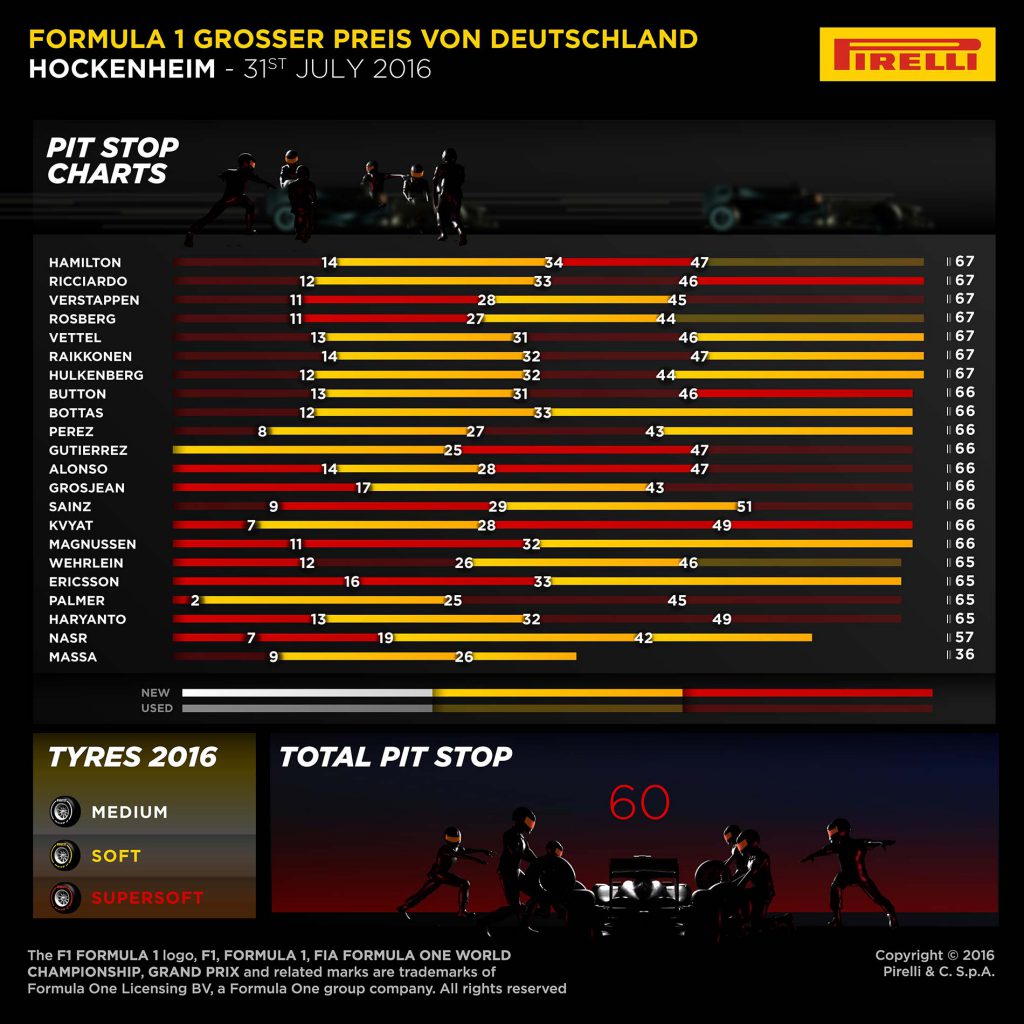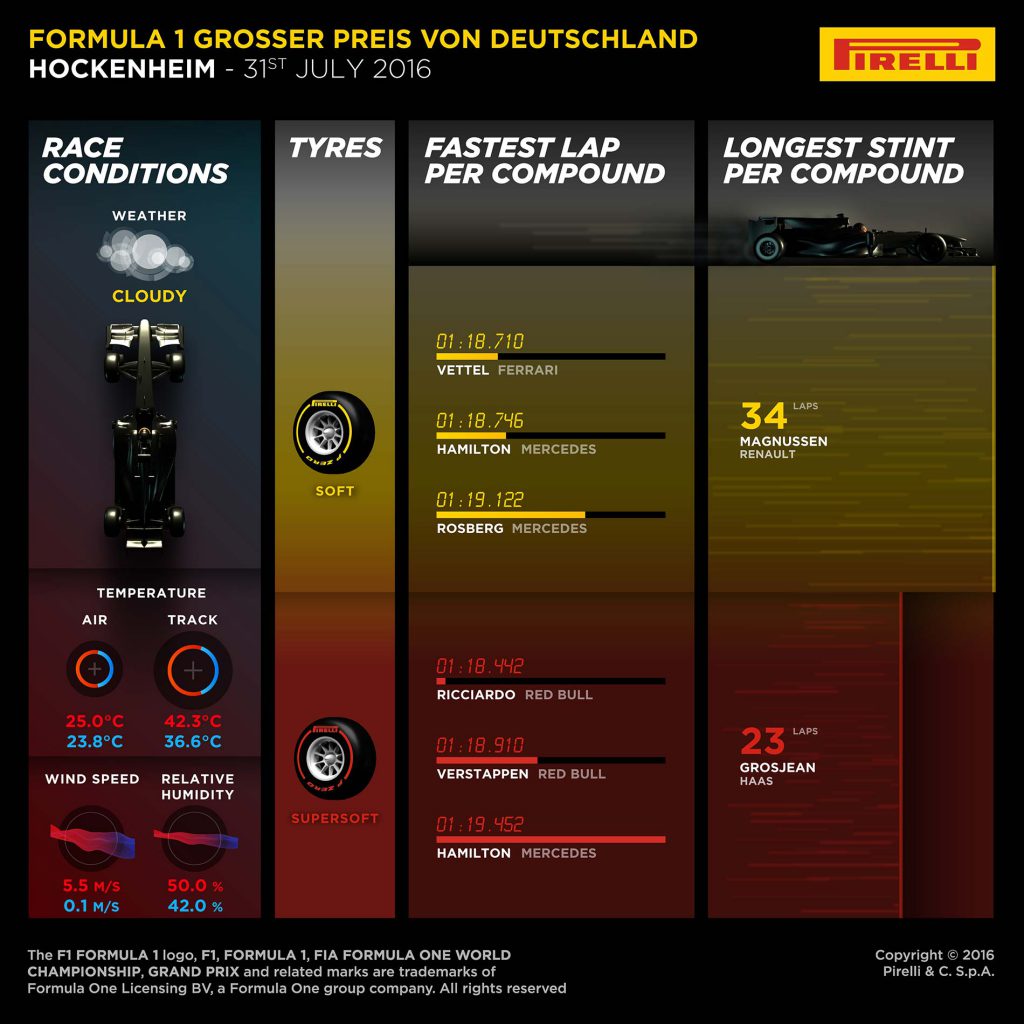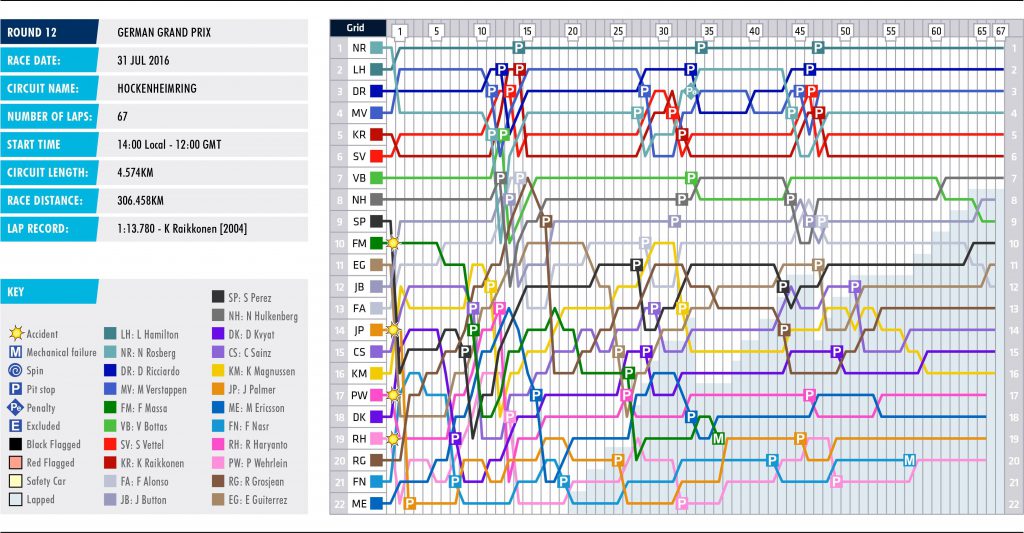German Grand Prix 2016
2 Aug 2016
Race 12 – 67 Laps – 4.574km per lap – 306.458km race distance – medium tyre wear
German GP F1 Strategy Report Podcast – our host Michael Lamonato is joined by Abhishek Takle – F1 journalist.
The Hockenheimring returned to the Formula 1 calendar as host to round 12 of the 2016 season, with the German Grand Prix being the final race before the summer break. Lewis Hamilton dominated after a strong start to take his sixth win of the year.
Daniel Ricciardo and Max Verstappen put in strong performances to score Red Bull’s first double podium of the season, finishing in second and third. Nico Rosberg lost further ground in the championship race with a fourth place on home soil.
The race threw up plenty of interesting strategy headlines, with a variety of different options being used up and down the grid. Here are the main strategy stories to emerge from the German GP.

Two laps for Dany Ric
Tyre degradation was higher in Germany than at previous races, meaning any extra laps completed on a tyre in qualifying could have had an impact on the first stints of the race. Ricciardo had to go for two laps on his fastest Q2 run, with those super-soft tyres then being used at the start of the race.
This meant they weren’t quite as fresh as the tyres his rivals were running but it proved to not have much of an impact, as he was able to stop one lap later than Verstappen and Rosberg. It didn’t particularly help his fight to beat Verstappen but he ended up moving ahead of him later on.
Gutierrez starts on softs
Esteban Gutierrez qualified in the coveted 11th grid position, meaning he was the first to have free reign of strategy when it came to choosing a tyre compound to start on. Haas opted to do something different and put him on the softs – the Mexican was the only driver to start on this tyre.
But a disastrous start caused him to fall to as low as 18th place, which had a big impact on the rest of his race. The strategy brought him back into play for a more positive result but he ended up finishing just six seconds off his first point of the season, coming home 11th.
Three stop rules the day
When F1 last visited Hockenheim, a two-stop strategy was the way to go. The tyres were more durable back then and the cars have evolved a lot since, but Pirelli predicted it would be very close between a two and a three stop race this year.
The three-stop was a safer bet, due to the tyre wear rates, but a two-stop could still work well if drivers were in clean air and could manage the tyres. Three trips to the pitlane proved to be the most popular choice in 2016, due to the tyre degradation and warm temperatures at the Hockenheimring.
But with a three stop comes a more diverse mix of compound strategies, we saw the leading four cars on different tyres during the final two stints. The soft and super-soft were the only compounds used throughout the race, as expected after limited running on the hardest compound (the mediums – seriously, what’s the point in them anyway?).
Vettel makes his own calls
Sebastian Vettel proved to be very vocal on the radio during the race when it came to race strategy. Before his final stop the German was told to pit but he replied “negative”, saying the super-soft tyres he was on could last a few more laps and were in good shape. He ended up pitting on lap 46 but he couldn’t take advantage of the fresher tyres compared to his rivals and ended up finishing well clear of the top four in fifth place.
Perez does the undercut
Sometimes the undercut doesn’t work all that well but it proved to be pretty handy in Germany, Perez leapfrogged several cars with early stops. He had a poor first lap, describing it as the “worst start” of his career, but a strategy change from Force India helped him move up the order. All of his three stops were earlier than his rivals and he used his strong tyre management skills to move up to 10th place in the closing stages.
Ambitious Bottas
Williams tried a two-stop strategy for Valtteri Bottas but the brave move didn’t work, the Finnish driver pitted to change from super-softs to softs on lap 12 and then went for another fresh set of softs on the 33rd tour of the race.
The long final stint didn’t quite work and Bottas ended up losing ground and a position to Jenson Button in the final laps, just holding off the hard-charging Perez. It was a similar story for Fernando Alonso, he was on a three-stop race but McLaren struggled more with degradation and the Spaniard ended up falling out of the top 10 with a few laps to go.
Rosberg doesn’t have the pace
Rosberg picked up a five-second penalty for forcing Verstappen off the road at Turn 6 and it was served at his final stop, but a stopwatch problem – according to Toto Wolff – meant the wait before the pit crew got to work was eight seconds instead. This cost Rosberg time but he lacked pace throughout the entire race.
The German dropped from first to fourth on lap one and struggled to fight back early on. He at one stage found himself up in second place after a super-soft second stint and a third stint on the softs, but the penalty cost him dearly and he ended up closing in on Verstappen late on, coming within two seconds of third place.
Hamilton out front
But while he looked less comfortable compared to Rosberg in practice, it all came together for Hamilton on race day. He took the lead at the start, opened up an advantage and put in a straightforward three-stop race, pitting on laps 14, 34 and 47 – going for a super-soft/soft/super-soft/soft strategy. It worked well and he crossed the line well clear of Ricciardo.
Jack Leslie @JackLeslieF1
Longest Stints
Medium: Not used
Soft: Magnussen (34 laps)
Supersoft: Grojean (23 laps)
Most Stops
3
All the Data
Thanks to Pirelli Motorsport for the detailed infographics


Stints by Driver
|
|
|||||||||||||||||||||||||||||||||||||||||||||||||||||||||||||||||||||||||||||||||||||||||||||||||||||||||||||||||||||||||||||||||||||||||||||||||||||||||||||||||||||||||||||||||||||||||||||||||||||||||||||||||||||||||||||||||||||||||||||||||||||||||||||||||||||||||||||||||||||||||||||||||||||||||||||||||||||||||||||||||||||||||||||||||||||||||||||||||||||||||||||||||||||||||||||||||||||||||||||||||||||||||||||||||||||||||||||||||||||||||||||||



 Safety Car
Safety Car 3. Ricciardo
3. Ricciardo 5. Vettel
5. Vettel 6. Rosberg
6. Rosberg 8. Grosjean
8. Grosjean 9. Ericsson
9. Ericsson 11. Perez
11. Perez 14. Alonso
14. Alonso 19. Massa
19. Massa 20. Magnussen
20. Magnussen 26. Kvyat
26. Kvyat 88. Haryanto
88. Haryanto
